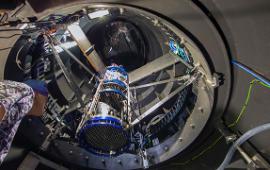Swinburne astronomers to help solve mystery of the Universe

In Summary
- The Taipan survey will map millions of galaxies in the southern hemisphere.
- Swinburne astronomers will play a major role in helping to determine the current expansion rate of the Universe with one per cent precision.
Swinburne will play a major role in helping to solve the mystery of the expansion rate of the Universe as part of a ground-breaking survey of the galaxy, known as the Taipan survey.
For the first time astronomers will be able to measure the distances of millions of galaxies in the southern sky as part of the Federal Government’s $6.37 million refurbishment of the TAIPAN facility on the 1.2 meter UK Schmidt Telescope near Coonabarabran in New South Wales.
The survey using the refurbished telescope will enable researchers to measure the current expansion rate of the Universe with one per cent precision, resolving a long standing discrepancy between previous measurements.
The nagging discrepancy has been left because two previous measurements, the ‘distance ladder’ method and the method of measuring radiation left over from the Big Bang, don’t match.
Swinburne’s ARC Future Fellow and Taipan survey member, Dr Edward Taylor, says the survey will provide the most complete survey of southern hemisphere stars and galaxies ever undertaken by measuring up to two million galaxies and two million stars to investigate dark energy, dark matter and how galaxies and stars formed and evolved.
“By mapping all the sky we can see from the south, this survey will form the standard map of our half of the sky for the next 15-20 years,” he says.
“It will become the go to map for astronomers of the southern half of the universe.”
The TAIPAN facility will use a new technology involving mini robots known as Starbugs to undertake the survey.
These mini robots rapidly and accurately align the optical fibres of a telescope to target stars and galaxies, making astronomical surveys faster and more efficient by cutting down a telescope’s configuration time from one hour to two to three minutes.
Dr Taylor says this is what will make to possible to map the whole sky in a few years rather than decades.
“These mini robots are demonstrator technology leading up to the next generation of 30m class telescopes. This is the start of the next generation or two in astronomy,” Dr Taylor says.
Swinburne astronomer and lead scientist at Australian Science Channel, Associate Professor Alan Duffy, says the survey will help determine why the Universe is accelerating as it expands.
“Now we need to answer why this incredible event is occurring,” he says.
“TAIPAN will help us do that by measuring the position of galaxies and track the rate at which they appear to move apart.
“Thanks to revolutionary new technology it can do this more precisely and rapidly than ever before.
“We suspect an entirely new property of space-time, known as dark energy, is driving this accelerating expansion but it’s so strange, so unusual that we need these revolutionary new facilities to get the data that can help us make sense of it!”
Editors note: TAIPAN refers to the hardware and facilities while Taipan refers to the galaxy survey

